Related Research Articles
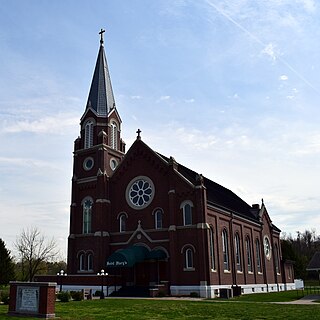
Pierce City, formerly Peirce City, is a city in southwest Lawrence and northwest Barry counties, in southwest Missouri, United States. The population was 1,292 at the 2010 census. In 2010, the town annexed property along Route 97 into Barry County to a point just north of U.S. Route 60. It was estimated to be 1,309 by the City of Pierce City as of July 1, 2019.
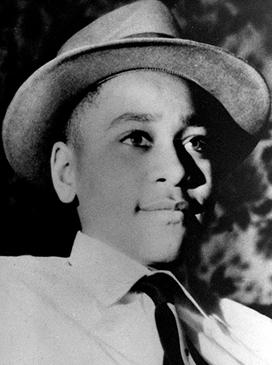
Emmett Louis Till was an African American teenager who was abducted, tortured, and lynched in Mississippi in 1955 after being accused of offending a white woman, Carolyn Bryant, in her family's grocery store. The brutality of his murder and the acquittal of his killers drew attention to the long history of violent persecution of African Americans in the United States. Till posthumously became an icon of the civil rights movement.
The Magical Negro is a trope in American cinema, television, and literature. In the cinema of the United States, the Magical Negro is a supporting stock character who comes to the aid of white protagonists in a film. Magical Negro characters, often possessing special insight or mystical powers, have long been a tradition in American fiction. The old-fashioned word "Negro" is used to imply that a "magical black character" who devotes himself to selflessly helping whites is a throwback to racist stereotypes such as the "Sambo" or "noble savage".

The Rosewood massacre was a racially motivated massacre of black people and the destruction of a black town that took place during the first week of January 1923 in rural Levy County, Florida, United States. At least six black people were killed, but eyewitness accounts suggested a higher death toll of 27 to 150. In addition, two white people were killed in self-defense by one of the victims. The town of Rosewood was destroyed in what contemporary news reports characterized as a race riot. Florida had an especially high number of lynchings of black men in the years before the massacre, including the lynching of Charles Strong and the Perry massacre in 1922.
Sundown towns, also known as sunset towns, gray towns, or sundowner towns, are all-white municipalities or neighborhoods in the United States and Canada that were most prevalent before the mid-20th century, which practiced a form of racial segregation by excluding non-whites via some combination of discriminatory local laws, intimidation or violence. The term came into use because of signs that directed "colored people" to leave town by sundown.
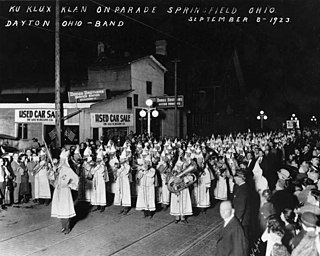
The nadir of American race relations was the period in African-American history and the history of the United States from the end of Reconstruction in 1877 through the early 20th century, when racism in the country, and particularly anti-black racism, was more open and pronounced than it had ever been during any other period in the nation's history. During this period, African Americans lost access to many of the civil rights which they had gained during Reconstruction. Anti-black violence, lynchings, segregation, legalized racial discrimination, and expressions of white supremacy all increased. Asian Americans were also not spared from such sentiments.

Coonskin is a 1975 American live-action/animated satirical crime film written and directed by Ralph Bakshi. The film references the Uncle Remus folk tales, and satirizes the blaxploitation film genre as well as Disney's racist film Song of the South, adapted from the Uncle Remus folk tales. The film's narrative concerns three anthropomorphic Uncle Remus characters, Br'er Rabbit, referred to as Brother Rabbit, Br'er Fox, referred to as Preacher Fox, and Br'er Bear, referred to as Brother Bear. They rise to the top of the organized crime racket in Harlem, encountering corrupt law enforcement, con artists, and the Mafia, in a satire of both racism within the Hollywood film system, and America itself. The film stars Philip Thomas, Charles Gordone, Barry White, and Scatman Crothers, all of whom appear in both live-action and animated sequences.

Rosewood is a 1997 American historical drama film directed by John Singleton, inspired by the 1923 Rosewood massacre in Florida, when a white mob killed black people and destroyed their town. In a major change, it stars Ving Rhames as an outsider who comes into Rosewood and inspires residents to self-defense, wielding his pistols in a fight. The supporting cast includes Don Cheadle as Sylvester Carrier, a resident who was a witness, defender of his family and victim of the riot; and Jon Voight as John Wright, a sympathetic white store owner who lives in Rosewood. The three characters become entangled in an attempt to save people from racist White people attacking the Black residents of Rosewood.

The Hamburg Massacre was a riot in the United States town of Hamburg, South Carolina, in July 1876, leading up to the last election season of the Reconstruction Era. It was the first of a series of civil disturbances planned and carried out by white Democrats in the majority-black Republican Edgefield District, with the goal of suppressing black Americans' civil rights and voting rights and disrupting Republican meetings, through actual and threatened violence.

The Wilmington insurrection of 1898, also known as the Wilmington massacre of 1898 or the Wilmington coup of 1898, was a coup d'état and a massacre which was carried out by white supremacists in Wilmington, North Carolina, United States, on Thursday, November 10, 1898. The white press in Wilmington originally described the event as a race riot caused by black people. Since the late 20th century and further study, the event has been characterized as a violent overthrow of a duly elected government by a group of white supremacists.

The People's Grocery lynchings of 1892 occurred on March 9, 1892, in Memphis, Tennessee, when black grocery owner Thomas Moss and two of his workers, Will Stewart and Calvin McDowell, were lynched by a white mob while in police custody. The lynchings occurred in the aftermath of a fight between whites and blacks and two subsequent shooting altercations in which two white police officers were wounded.
In the United States, a freedmen's town was an African American municipality or community built by freedmen, formerly enslaved people who were emancipated during and after the American Civil War. These towns emerged in a number of states, most notably Texas. They are also known as freedom colonies, from the title of a book by Sitton and Conrad.
Marco Williams is a documentary filmmaker and professor of film production at Northwestern University. His films have received several awards, including the Gotham Documentary Achievement Award for Two Towns of Jasper, and he has been nominated three times for the Sundance Film Festival grand jury prize.
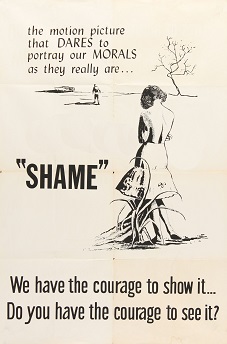
The Intruder, also known as I Hate Your Guts, Shame and The Stranger, is a 1962 American drama film directed and co-produced by Roger Corman and starring William Shatner. The story, adapted by Charles Beaumont from his own 1959 novel of the same name, depicts the machinations of a racist named Adam Cramer, who arrives in the fictitious small Southern town of Caxton in order to incite white townspeople to racial violence against Black townspeople and court-ordered school integration.
Murray Bishoff is a writer at The Monett Times in Monett, Missouri. Formerly a contributor to Comics Buyer's Guide, Bishoff won an Inkpot Award in 1980. Bishoff is also known for his research and writings on the 1901 fifteen-hour lynching spree in Pierce City, Missouri, during which white residents murdered three African American residents and caused nearly 300 others to flee the city. His writings include a series of articles published to commemorate the 90th anniversary of the event and the historical novel Cry of Thunder. In addition, the town's cemetery holds a marker to the event paid for in large part by Bishoff and the Pierce City Museum hosts an exhibit which Bishoff created. He has also publicly spoken about the event to CNN and appears in a documentary about the event, Banished: How Whites Drove Blacks out of Town in America.
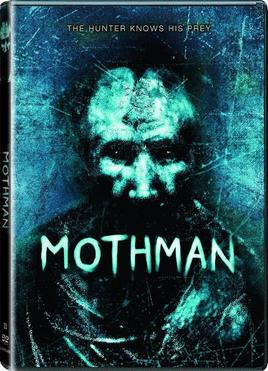
Mothman is a 2010 television film directed by Sheldon Wilson and starring Jewel Staite and Connor Fox. The film premiered on Syfy on April 24, 2010, and was released on DVD on October 25, 2011. The film features the song "Fuel" by Surfact in the end credits and on the DVD menu. The film received negative reviews.

In Forsyth County, Georgia, in September 1912, two separate alleged attacks on white women in the Cumming area resulted in black men being accused as suspects. First, a white woman reportedly awoke to find a black man in her bedroom; then days later, a white teenage girl was beaten and raped, later dying of her injuries.
The Ocoee massacre was a mass racial violence event that saw a white mob attack numerous African-American residents in the northern parts of Ocoee, Florida, a town located in Orange County near Orlando. Previously inhabited by the Seminoles, Ocoee was the home to 255 African-American residents and 560 white residents according to the 1920 Census. The massacre took place on November 2, 1920, the day of the U.S. presidential election leaving a lasting political, but also community impact, as the 1930 census shows 1,180 whites, 11 Native Americans, and 2 African Americans (0.2%).

The Ellenton riot or Ellenton massacre occurred in September 1876 and took place in South Carolina in the United States. The massacre was preceded by a series of civil disturbances earlier that year following tensions between the Democratic Party and the Republicans. Author Mark M. Smith concluded that there was one white and up to 100 blacks killed, with several white people wounded. While John S. Reynolds and Alfred B. Williams cite much lower numbers.
John Carter was an African-American man who was murdered in Little Rock, Arkansas, on May 4, 1927. Grabbed by a mob after another Black man had been apprehended for the alleged murder of a white girl, Carter was hanged from a telephone pole, shot, dragged through the streets, and then burned in the center of the city's Black part of town with materials that a white crowd of perhaps 5,000 people had looted from nearby stores and businesses.
References
- ↑ "'Banished' Recounts History of Forced Segregation". NPR.org.
- ↑ Dargis, Manohla (September 26, 2007). "When Jim Crow Came to Town, With Eviction Notices". The New York Times.